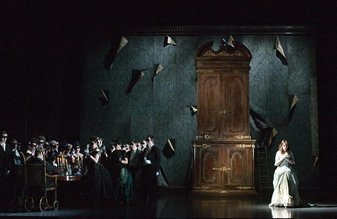As the Gaiety theatre curtain slowly rises during the overture, a chorus eyeballs us from the Stygian gloom and we know that we are going to witness a particularly dark version of this well-known story.
And no better way to achieve this than to give it the Victorian Gothic treatment, with the House of Capulet's massive wall of faded peeling wallpaper unable to cover the fault lines, about to erupt into a full blown tragedy of seismic proportions, which – as the chorus constantly reminded us - will rock the very foundations of society. Even the opening act birthday party for Juliette's coming of age looked as if everything had been coated with a particularly atrophying varnish draining all of colour and vitality, so effective was the work of Leslie Travers and Chris Davey (design and lighting respectively). The ladies' elegant ball  gowns were muted and fusty and their voluminous hair seemed to crush their doom laden features. When not covered with sombre black masks, the chorus' blackened eyes conveyed a sickly demeanour suggesting too much laudanum. In the centre, like a mausoleum, was a gigantic Victorian armoire of dark browns. Inside is both damnation and salvation: it served both as Juliette's bedroom and Friar Lawrence's medicine chest. It was all horrible, sickly, portentious, and it all worked a treat.
gowns were muted and fusty and their voluminous hair seemed to crush their doom laden features. When not covered with sombre black masks, the chorus' blackened eyes conveyed a sickly demeanour suggesting too much laudanum. In the centre, like a mausoleum, was a gigantic Victorian armoire of dark browns. Inside is both damnation and salvation: it served both as Juliette's bedroom and Friar Lawrence's medicine chest. It was all horrible, sickly, portentious, and it all worked a treat.
Even the big hit of the opera, Juliette's waltz-like 'Je Veux Vivre', a favourite aerial display piece for concert sopranos, here becomes a teenager making the time-honoured protest about being tied into a loveless marriage, in this case with Paris – “I don't wanna to get married, I wanna live a bit first” this girl was saying. It was wonderful to experience this aria in context, performed at various tempi with real angst, brilliantly acted by a terrific Nathalie Manfrino playing Juliette. Michael Spyres as Roméo, with a heroic tenor timbre, more than matched his lover in voice. The heavy musty Victorian ambience was further enhanced by the rich baritone of Marcel Vanaud's Count Capulet and rumbling bass of Paolo Battaglia as Frère Laurent. It's difficult to perform a tricky aria (based on the Queen Mab speech) while pretending that you're absolutely trolleyed but Andrew Ashwin as Mercutio managed to pull this off. The only real light relief was from mezzo soprano Imelda Drumm in a trouser role as Roméo's servant Stéfano which was a gem of a performance.
Some judicious cuts meant that we had a lot of duets, but there was some action such as the sword fights between Tybalt and Mercutio, and here director Annilese Miskimmon's masterful use of chorus interacting with principals was most evident: the second fight became a quick guns-at-dawn which was a wise decision and I had to admire Spyres' and Ashwin's teamwork when Roméo single handedly shouldered the dead Mercutio off the stage – especially when a half dozen men got to carry off the dead Tybalt on his exit. Tybalt's corpse held high with arms stretched added to the epic universality of the story, climaxing as it did with a another full-on blast from the masses just before the interval.
Indeed the only caveat I had about the staging was the frequent short intervals between the first four acts: house lights up always breaks the mood and I wondered whether the serfs of the Capulet household could not have rushed on in, well, a serf-like manner and shifted the furniture – especially as they seemed to manage this in the later acts. Wardrobe wise, I was baffled by Roméo's final appearance in a hoodie, given the fact that the nineteenth century ambience was so well evoked; I'm not sure it was wise to update so drastically in the last act.
In the pit, conductor Jérôme Pillement and chorus didn't get off to the best of starts as the a capella prologue by the chorus was marred by a serious loss in pitch, while there seemed a lack of ensemble in Act I. However, by Act II all was well again, with Maestro Pillement eliciting a beautiful muted pianissimo from strings and brass giving us a restful liturgical sound with brooding trombones and horns. The fast tempi were lively with nimble dexterous playing from the RTÉ Concert Orchestra. The music for the funeral scene in Act IV with organ was particularly effective, complementing the profusion of on-stage candles and descending snowflakes.
Finally, technicians don't often get mention but whoever was controlling or calling that great wall of velvet that is part and parcel of the Gaiety (the house curtain) deserves a bouquet. I have never seen such variations of curtains up and down at so many speeds. They were timed to the very last beat of the bar and as the final curtain fell, it's surely important to record that with a mooted new national opera company this year we could be witnessing the last perfomance of Opera Ireland as we know it. An organisation which has re-invented itself so radically since the DGOS days may have reached the end of a very important chapter. Then again, with this current crisis, who knows what will happen?
John White is a Theatre Director and Conductor.